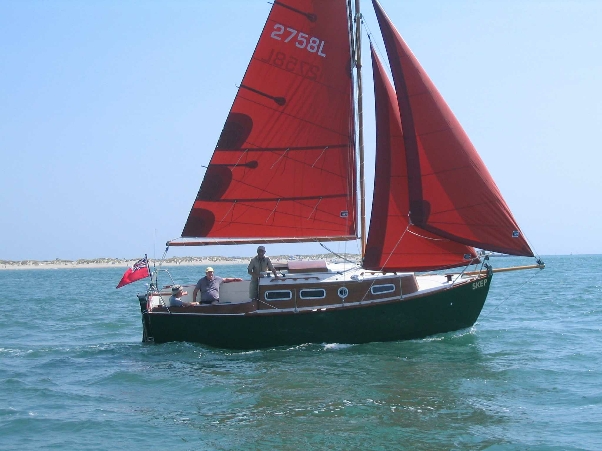STUART ROY - NAVAL ARCHITECT
Fellow of the Royal Institution of Naval Architects & Chartered Engineer
The yacht “Skep”, which completed sailing trials in the Solent in July 2013, has a number of interesting features, including the patented Steynor lifting bulb keel. This unique device enables the yacht to sail with a fin keel and bulb, providing better windward performance and stability than could be achieved with a centreboard or bilge keels. But then for shallow water and for trailing the keel is raised by an electric motor and “folded” into its case under the floor of the cabin. Details of the keel and its mechanism are shown on the Steynor website. The keel is not seen at all in the cabin, which has standing headroom, a full 4-berth layout, large heads compartment and a well-equipped galley with fridge and diesel-powered cooker. The yacht also has a full range of systems including hot water at the shower, central-heating powered from the cooling circuit of the 14hp diesel engine, a holding tank for the toilet, full electrics for domestic and navigation lights as well as comprehensive electronics for navigation. All this has been achieved in a 25ft yacht that is still light enough to be towed home by a 4 by 4 vehicle.
The yacht had to be suitable for home-building by a single person as a first boat-building project. Consequently the construction of the yacht was specifically designed to suit the situation and the workshop size with its limited width of doorways. The hull was built upside-down in ship style with the frames being erected first and then clad with panels. As the hull had been computer-lofted with the panels as developable surfaces it was only necessary to draw out the frame shapes from the offset table before cutting the frame pieces (1) from utile (mahogany) and gluing them at the chine positions. The frames were given pairs of gussets at the chines so that there was adequate strength for them to be notched to take longitudinal stringers of douglas fir. The frames were then set up carefully (2) before being planked with 12mm marine plywood.
After planking, the hull was sheathed with glass/epoxy, smoothed, painted, antifouled and prepared for extracting from the workshop (3). After turning over the hull very carefully, it was returned to the workshop for the interior to be fitted. The basic structure of the hull, representing 10 months of work, can be seen at this stage (4) before the interior was fitted out. After fitting some bulkheads and interior structure a 14hp Beta diesel engine was installed. Then the rest of the fit-out followed. Meanwhile the keel assembly had been built full size in plywood and fully tested before the real thing was manufactured in cast iron and stainless steel at Irons Brothers in Cornwall. On arrival at the workshop the keel and its lifting mechanism were tested extensively before being installed in the boat. The keel test can be seen in this short video.
The interior fit-out (5) and installation of systems took around 1½ years before the boat came out of the workshop to have its rudder, deck gear, rig and sails added. A test launch on a local river (6) showed that the engine and keel systems were all working satisfactorily before the yacht went on show at Beale Park in June (7), gaining a lot of interest from the visitors. Finally it was time to do some sailing trials on a short cruise. With three persons on board, she proved to be very comfortable. She is perfectly balanced on the helm and handles well under sail or power. She feels much larger than her length and with all the sail controls led back to the cockpit she should provide safe cruising when single-handed or fully crewed.
Following a cruise from Plymouth to Cowes, an entry in the 2014 Round the Island Race and a return trip to Plymouth the owner reported:
The race itself as I am sure you know lacked any significant wind. SKEP was performing very well but the breeze eventually deserted us and we ended up drifting around off St. Catherine's at 16.30 and at that stage retired. We motored on round and tied up at 2300 having started the day at 0500!
On the return trip we got some extended sailing in at last. We spent the Sunday night in Yarmouth then went to Poole, lunch in Lulworth Cove, Wareham, Dartmouth, Salcombe, QAB Plymouth. The last two legs were in some fairly lively conditions which SKEP coped with easily.
From this first serious outing - firstly a big thank you to you for designing an excellent little yacht, she performs beautifully in all conditions and is a joy to sail. She has a spacious comfortable dry cockpit and also plenty of room below for a crew of three to live aboard in reasonable comfort. From my perspective she is perfect.
Secondly after this trip I can report that the yachting fraternity like her very much. We spent every day of our trip being asked about her either when in port or when at sea with yachts apparently trying to run us down just to get close enough to look and ask about her. Even during the race we were bombarded with questions by passing boats. So a big thank you for coming up with such a beautiful design.
The yacht had to be suitable for home-
After planking, the hull was sheathed with glass/epoxy, smoothed, painted, antifouled and prepared for extracting from the workshop (3). After turning over the hull very carefully, it was returned to the workshop for the interior to be fitted. The basic structure of the hull, representing 10 months of work, can be seen at this stage (4) before the interior was fitted out. After fitting some bulkheads and interior structure a 14hp Beta diesel engine was installed. Then the rest of the fit-
The interior fit-
Following a cruise from Plymouth to Cowes, an entry in the 2014 Round the Island Race and a return trip to Plymouth the owner reported:
The race itself as I am sure you know lacked any significant wind. SKEP was performing very well but the breeze eventually deserted us and we ended up drifting around off St. Catherine's at 16.30 and at that stage retired. We motored on round and tied up at 2300 having started the day at 0500!
On the return trip we got some extended sailing in at last. We spent the Sunday night in Yarmouth then went to Poole, lunch in Lulworth Cove, Wareham, Dartmouth, Salcombe, QAB Plymouth. The last two legs were in some fairly lively conditions which SKEP coped with easily.
From this first serious outing -
Secondly after this trip I can report that the yachting fraternity like her very much. We spent every day of our trip being asked about her either when in port or when at sea with yachts apparently trying to run us down just to get close enough to look and ask about her. Even during the race we were bombarded with questions by passing boats. So a big thank you for coming up with such a beautiful design.
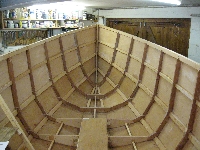
Calypso 2007
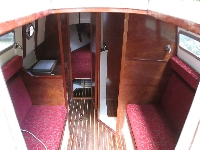
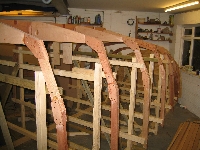
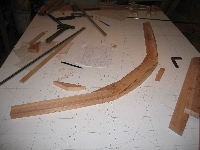
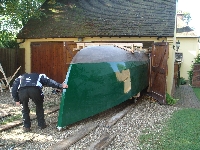
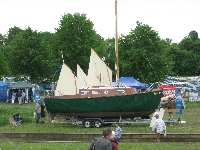
1
2
3
4
5
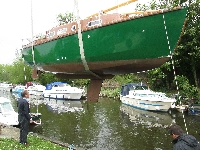
6
7
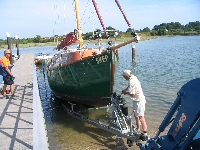
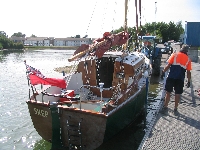
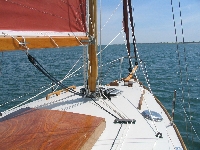
25ft Ply/Epoxy Gaff Cutter “Skep”
Incorporating a Radical New Lifting Bulb Keel
